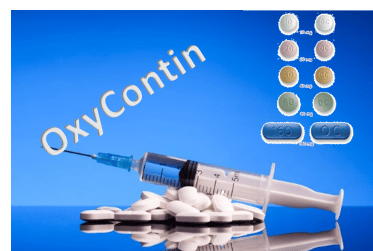OxyContin (oxycodone) is an opioid pain medication. Oxycodone is a morphine-like, strong pain-relief medicine used for the relief of severe pain that is unresponsive to less potent pain-relief medicines (analgesics).
An opioid is sometimes called a narcotic. OxyContin is a brand (trade name) of controlled-release oxycodone. It releases oxycodone slowly over a period of 12 hours.
OxyContin is used to treat moderate to severe pain that is expected to last for an extended period of time. OxyContin is used for around-the-clock treatment of pain. It is not to be used on an “as-needed” basis for pain.
Mis-use:
A single OxyContin pill (when crushed, snorted or injected) can deliver the same amount of oxycodone as 16 Percocet pills. You risk becoming addicted when using OxyContin this way.
| Other names for Oxycodone are often variants of different brand names, which include: | |
| Blue | This is a reference to the color of the pill itself, but it is not the most popular nickname because many drugs come in the form of a blue pill. |
| Kicker | This is a common street name for oxycodone. Rather than describing the pill, however, this nickname describes what the drug can do to a person once the key ingredient is released throughout the body. It often makes people feel high creating a mental and physical “kick.” |
| Percs | This street name is a reference to the brand-name Percocet, which contains oxycodone. |
| 512s | This is a reference to a generic brand of Percocet that prints 512 on the pill. |
| Hillbilly heroin | This was originally named for another drug (hydromorphine), but the term is now used for oxycodone as well as OxyContin. |
| Others | OC, Oxy, Oxycotton, killers, Oxy 80’s |
Short-Term Effects of Oxycodone
When taken as prescribed, oxycodone can bring about the following desirable feelings: Euphoria, Extreme relaxation, reduced anxiety, pain relief, sedation,
Side effects may include:
Nausea, Vomiting, Loss of appetite, Dry mouth, Constipation, Dizziness, Stomach pain, Drowsiness, Flushing, Sweating, Weakness, Headache, Mood changes.
NOTE: Some of the most dangerous side effects of oxycodone use are associated with the breathing problems that it may create. A markedly slowed respiratory rate can quickly turn life-threatening, especially in overdose situations. Rapid effects of oxycodone use are particularly dangerous when combined with alcohol.
Oxycodone Dependence
Oxycodone is classified as a Schedule II drug, meaning that it has been determined to have highly addictive properties and has a high potential for dependence both psychological and physical.
Psychological dependence often begins wanting to continue to experience the feeling of euphoria that they initially experience. Users may continue seeking higher doses in hopes of amplifying the effects.
Physical dependence on oxycodone increases as a user’s body adapts to a continuous presence of the drug in their system. After some time, certain physiologic processes are impeded when the drug is no longer in their system. Also, users ay quickly build a tolerance to the drug which means more and more of the drug is needed in order to achieve the same effects.
Withdrawal symptoms:
| Frequent nausea and vomiting Sleeplessness Abdominal pain Diarrhea Heavy sweating | Runny nose Hot and cold flashes Coughing fits Anxiety and agitation Goosebumps |
Here are some signs of abuse /overdose which may include:
- Difficulty breathing.
- Slowed or stopped breathing.
- Excessive sleepiness.
- Dizziness.
- Fainting.
- Limp or weak muscles.
- Narrowing or widening of the pupils.
- Cold, clammy skin.
- Slow or stopped heartbeat.
- Cyanosis (blue color of skin, fingernails, lips, or mouth area).
- Loss of consciousness or coma.
Summary/Final thoughts:
OxyContin is indicated for the management of pain severe enough to require daily, around-the-clock, long-term opioid treatment and for which alternative treatment options are inadequate. Because of the risks of addiction, abuse, and misuse with opioids, even at recommended doses, and because of the greater risks of overdose and death with extended-release opioid formulations, OxyContin should be used by those for whom alternative treatment options (e.g., non-opioid analgesics or immediate-release opioids) are ineffective, not tolerated, or would be otherwise inadequate to provide sufficient management of pain.
OxyContin contains oxycodone, a Schedule II controlled substance. OxyContin exposes users to the risks of opioid addiction, abuse, and misuse. Because extended-release products such as OxyContin deliver the opioid over an extended period of time, there is a greater risk for overdose and death due to the larger amount of oxycodone present.
Abuse or misuse of OxyContin by crushing, chewing, snorting, or injecting the dissolved product will result in the uncontrolled delivery of oxycodone and can result in overdose and death.







